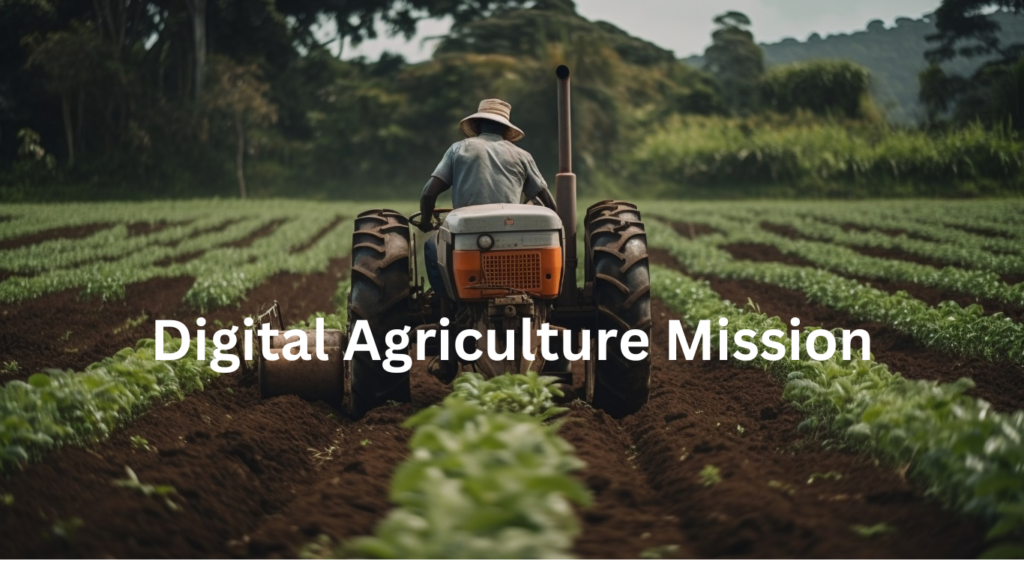The Digital Agriculture Mission is a revolutionary initiative by the Government of India aimed at transforming the agricultural sector through the use of cutting-edge digital technologies. The scheme seeks to integrate modern technology with traditional farming practices to improve productivity, reduce costs, and ensure sustainable growth for farmers. By enabling digital platforms, data analytics, and ICT (Information and Communication Technology), the mission aims to make agriculture more efficient, inclusive, and climate-resilient.

In this blog, we will explore the scheme’s objectives, key features, benefits, eligibility criteria, and how it is set to empower Indian farmers with the help of technology.
- Launch Date: September 2024
- Launched By: Ministry of Agriculture and Farmers Welfare, Government of India
Implemented By: Department of Agriculture, Cooperation and Farmers Welfare
Objectives of the Digital Agriculture Mission :
Integrate digital technologies like AI (Artificial Intelligence), IoT (Internet of Things), remote sensing, and drones to improve farming practices.
Enhance productivity through precision farming, crop monitoring, and effective resource utilization.
Provide farmers with data-driven insights and solutions to make informed decisions about crop selection, pest control, and market conditions.
Promote sustainable agricultural practices that reduce dependency on chemical inputs and minimize environmental impact.
Create digital platforms to connect farmers with buyers, ensuring better pricing, market access, and reduced dependency on intermediaries.
Features of the Digital Agriculture Mission :
Digital Infrastructure Development:
Establishing infrastructure like broadband connectivity, cloud computing, and digital platforms in rural areas to help farmers access real-time data and services.
Data Analytics and Decision Support Systems:
Using big data analytics, AI, and machine learning algorithms to process agricultural data and provide farmers with actionable insights to improve crop yield and efficiency.
Mobile Apps and E-Governance:
Launching mobile applications to provide weather forecasts, soil health information, market prices, and other critical agricultural services to farmers in remote locations.
Precision Agriculture Tools:
Encouraging the use of IoT sensors, drones, and satellite technology to monitor crops, detect diseases, and optimize irrigation systems.
Capacity Building and Training:
Offering training programs and workshops for farmers on how to use digital tools and technologies to improve agricultural productivity.
Digital Payment Systems:
Promoting the use of digital payment systems to facilitate easier transactions between farmers and buyers, reducing cash dependency and promoting financial inclusion.
Eligibility Criteria for the Digital Agriculture Mission :
Farmers:
All farmers in India, particularly those in rural areas, are eligible to benefit from the digital technologies introduced under this scheme.
Agri-Tech Startups:
Agritech companies and technology service providers working on digital solutions for the agriculture sector can also participate in the mission.
Agricultural Cooperatives and Farmer Groups:
Farmers’ cooperatives, Self-Help Groups (SHGs), and farmer producer organizations (FPOs) can also be part of the scheme and help spread awareness about digital agriculture practices.
State Governments and Local Authorities:
State governments and local bodies are involved in the implementation and monitoring of the mission at the regional level.
How to Apply for Digital Agriculture Mission Scheme:
Application Process for Farmers:
Farmers can access government platforms or visit local government offices to apply for digital services and training under the scheme.
Farmers may also be enrolled through local agricultural extension officers or agritech companies.
Agri-Tech Startups and Partners:
Technology companies and service providers can collaborate with the Ministry of Agriculture by registering their digital solutions on official platforms for potential government contracts.
Training and Capacity Building Enrollment:
Farmers can enrol in workshops and digital literacy programs organized by state and district agricultural departments.
Utilizing Digital Platforms and Apps:
Once enrolled, farmers can download mobile apps or access web portals that offer a wide range of services such as weather updates, soil health reports, and market prices.
visit the official digital agriculture mission website
Benefits of the Digital Agriculture Mission :
Improved Crop Yield:
Access to real-time data allows farmers to adopt precision farming techniques, improving crop yields and resource efficiency.
Reduced Input Costs:
Using digital tools for pest management, irrigation, and crop monitoring helps farmers optimize input usage, reducing waste and costs.
Better Market Access:
Digital platforms create direct connections between farmers and markets, ensuring better prices and reducing dependence on middlemen.
Data-Driven Decisions:
Farmers receive actionable insights about crop performance, soil health, weather, and pest risks, helping them make informed decisions.
Financial Inclusion:
Promotes digital payments, increasing financial inclusion for rural farmers and making financial transactions smoother and more transparent.
Sustainability:
Encourages environmentally friendly farming practices, reducing the carbon footprint and fostering long-term agricultural sustainability.
Read This also: pm surya ghar muft bijli yojana
Challenges of the Digital Agriculture Mission :
A large section of the rural population lacks digital literacy, which may limit the adoption of digital technologies.
Inadequate digital infrastructure, such as low internet penetration in rural areas, may hinder the success of the scheme.
The upfront cost of advanced technologies like drones and IoT devices may be a barrier for some farmers, even though the scheme promotes subsidies.
The use of digital tools raises concerns about data privacy and cybersecurity, especially in the case of sensitive agricultural data.
Achievements of the Digital Agriculture Mission :
Increased Technology Adoption:
Thousands of farmers across India have adopted digital tools and platforms, leading to better crop management and improved productivity.
Success Stories:
Several farmers have successfully improved their farming practices using digital tools, achieving higher yields and cost savings.
Capacity Building:
Thousands of farmers have undergone digital literacy and training programs, improving their understanding of modern farming techniques.
Government Support for Startups:
The scheme has provided a platform for agri-tech startups to develop innovative solutions, contributing to the growth of the digital agriculture ecosystem in India.
Conclusion:
The Digital Agriculture Mission is a groundbreaking initiative that is set to transform India’s agricultural landscape. By integrating modern technology with traditional farming methods, the mission aims to improve efficiency, sustainability, and the livelihoods of farmers across the country. It’s a step towards creating a tech-driven agriculture sector that ensures higher productivity, better market access, and reduced environmental impact.
As the government pushes forward with the Digital Agriculture Mission, the role of farmers, agritech companies, and state governments becomes crucial in ensuring its success. If you are a farmer, it’s time to embrace technology and explore the benefits of digital agriculture in your farming practices.
FAQs about Digital Agriculture Mission :
- Q: What is the Digital Agriculture Mission?
A: It is a government initiative to integrate digital technologies like AI, IoT, and data analytics into farming practices to improve productivity and sustainability. - Q: Who can benefit from the scheme?
A: Farmers, agri-tech startups, agricultural cooperatives, and government bodies can benefit from the scheme. - Q: How can farmers apply for digital agriculture services?
A: Farmers can apply through local government offices or online platforms offering digital agriculture services. - Q: What types of technologies are involved in the Digital Agriculture Mission?
A: The mission uses technologies like drones, satellite mapping, IoT sensors, AI, and data analytics to enhance farming operations. - Q: Does the scheme offer financial support for adopting technology?
A: Yes, the government provides subsidies and financial assistance for adopting digital tools and platforms in agriculture
All information provided in this blog is for general informational purposes only. We recommend verifying details from official government sources before applying to any scheme.


